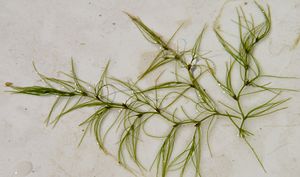Slender waternymph facts for kids
Quick facts for kids Slender waternymph |
|
|---|---|
 |
|
| Conservation status | |
| Scientific classification | |
| Genus: |
Najas
|
| Species: |
gracillima
|
| SynonymsThe Plant List | |
|
|
Najas gracillima, often called the slender waternymph, is a fascinating water plant that lives entirely underwater. It's part of the Hydrocharitaceae family, which includes many other plants that grow in water. You can find this plant in lakes and streams, where it helps create a home for fish and other aquatic creatures.
Contents
What is the Slender Waternymph?
The slender waternymph is a submerged plant, meaning it grows completely underwater. It has thin, delicate leaves that help it blend in with its watery home. This plant is important for the environment because it provides oxygen to the water and offers shelter for small fish and insects.
Where Does This Plant Live?
The slender waternymph is native to many parts of the world. This means it naturally grows there. You can find it in:
- Asia: Countries like China (in areas such as Fujian, Guangxi, and Taiwan), Japan, Korea, Iran, and parts of the Russian Far East.
- North America: It grows across eastern United States (most states east of the Mississippi River) and in parts of Canada (like Alberta and Ontario).
Introduced Locations
Sometimes, plants can be carried to new places by people or animals. When they start growing there, they are called "introduced" or "naturalized." The slender waternymph has been introduced to:
- Europe: Countries like France, Spain, and Italy.
- United States: Specifically in California.
Why is it Called Slender Waternymph?
The name Najas gracillima comes from Latin. "Gracillima" means "very slender" or "very graceful," which perfectly describes its thin, delicate appearance. "Waternymph" refers to its home in the water, like a mythical water spirit.
How Does it Grow?
Like many aquatic plants, the slender waternymph spreads by sending out new shoots. It can form dense patches in shallow waters, especially in calm areas of lakes and slow-moving streams. These dense patches are great hiding spots for young fish.


